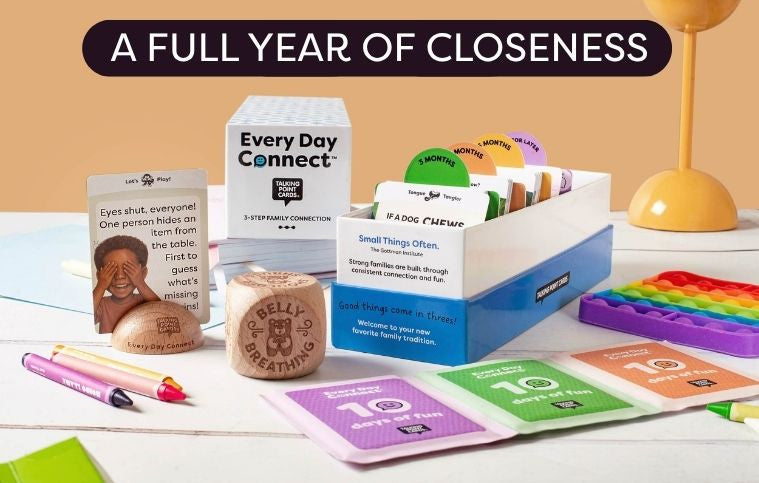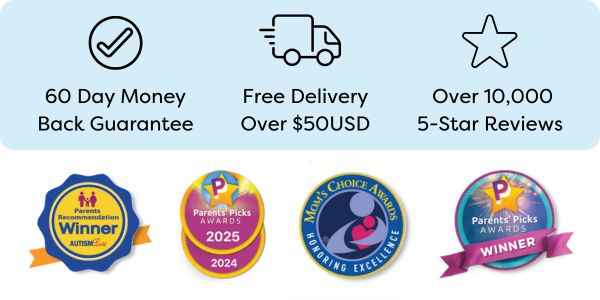The statistics are startling, but they’re hardly surprising.
We’re spending too much time with our screens and not enough time with our loved ones.
7
hrs 3mins
The average amount of time that an American adult spends looking at a screen every day.[1]
6
hrs 17mins
The average amount of time that an American family spends having quality family time every week.[2]
With a global average of 6 hours and 40 minutes[3] of daily screen time, it’s clear that things have gotten out of hand…
But that doesn’t even tell the whole story.
When screens first arrived in most households in the form of Television sets, they offered up a synchronous, communal activity that families could enjoy together after dinner.
But since then - and especially since the invention of the smartphone - screen-based entertainment has mutated into something that steals your attention away from your family and friends every chance it gets…
Now, we’re spending less time than ever actually talking to one another:
2003
46
mins
the time an average American spends having face-to-face social communication.[4]
2003
34
mins
Average American spent
having face-to-face social communication[5]
Overall
73
hours
That’s 73 fewer hours of socializing a year!
And no one has been harder hit by the screen time epidemic than kids and teens: A 2021 report from Common Sense Media found that 8-12 year-olds were spending 5 hours and 33 minutes a day of recreational screen time (up from 4 hours and 44 minutes in 2019).[6]
Common Sense Media also found that teenagers averaged 8 hours and 39 minutes a day of recreational screen time in 2021, which was up from 7 hours and 22 minutes a day in 2019.[7]
With several studies showing that high screen time and social media use contribute to worse mental health outcomes for young people[8/9], it’s no surprise that since 2010, anxiety has risen 139% for 18-25 year-olds and depression has risen over 150% for teenagers.[10]
It seems obvious, but it needs to be said: the huge rise in teenage screen time comes at a real cost to their mental health and social lives.
A recent study found that college-bound high school seniors spent one hour less per day having in-person social interaction in 2016 than they did in the late 1980s.[11]
And it’s not just teens who are spending more time alone with their phones and less time with other people.[12]
Percentage of time American Adults spend alone
2003
43.5%
2019
48.7%
2020
50.7%
So, we’re spending more time alone, less time talking to other people, and way more time on screens. But it gets even worse. The data about screen time and social interaction actually undersells how bad the problem truly is. Because when we carry around our phones everywhere we go, the amount of time we spend literally looking at the screen doesn’t capture how much they really dominate our attention:
A 2021 Pew survey found that 31% of American Adults admit to being “almost constantly” online.[13]
The statistics, once again, are even more stark for teens. A staggering 46% of teens reported being “almost constantly” online in 2021, up from 24% in 2015.[14]
When you’re “almost constantly online,” you’re basically always paying attention to your phone and at the whim of whatever notification pops up next.
Already in 2015, almost 90% of people admitted to using their phones during their most recent social interaction.[15]
So even when we’re out interacting with other people in the real world (which we now do for just 34 minutes a day), our attention is often elsewhere.
This phenomenon is called being “alone together,” and it might just be the biggest existential threat to quality time in the 21st century.
Time spent online
2021
31%
of American Adults admit to being “almost constantly” online.
2021
46%
teens reported being “almost constantly” online in 2021, up from 24% in 2015.
2015
90%
of people admitted to using their phones during their most recent social interaction
According to a 2019 study, the average UK family gained more than 30 minutes of potential time together per day from 2000 to 2015.[16]
But in reality, those same UK families spent 10 minutes less per day actually interacting with each other in 2015 than they did in 2000.[17]
The culprit? An added 40 minutes a day of “alone together time.”[18]
Even when you’re not content to be zoned out in front of a screen, conversation and quality time take (at least!) two to tango….
And we all know what it feels like when you’re trying to have a meaningful moment with someone, and they’re just too constantly online to care:
Screen time in relationships
51%
of couples say their partner is often or sometimes distracted by screens when they’re trying to have a conversation with them.[19]
70%
of couples say that technology interferes with their relationship on a daily basis.[20]
37%
of married Americans say their spouse is “often” distracted by a screen when they would prefer to talk or do something together.[21]
It’s not just couples who feel the effects of “phubbing” (snubbing another person in favor of your phone), either: 68% of parents say at least sometimes feel distracted by their phone when they’re spending time with their children.[22] 72% of parents feel that their teen is at least sometimes distracted by their phone when they’re trying to have a conversation with them.[23]
All of these numbers tell us what we already know to be true:
In 2024, there’s never been a bigger difference between: Time together and quality time together.
The good news? Talking Point Cards is here to help you create more quality time. Good conversation is the most time-tested way to create quality time with the people you love.
Screen time in relationships
2010
70%
Studies show the happiest people spend 70% more time having conversations than the unhappiest people.[25]
2023
Studies found that just one conversation with a friend a day increases happiness and reduces stress levels.[26]
2021
Studies found that couples who spent more time talking to each other were significantly more satisfied with their relationship.[27]
A 2018 study from MIT found that the number of “conversational turns” children had from the ages of 4 to 6 had a direct effect on their brain development and language processing skills.[24]
A 2010 study found that the happiest people spend 70% more time having conversations than the unhappiest people.[25] A 2023 study found that just one conversation with a friend a day increases happiness and reduces stress levels.[26] A 2021 study found that couples who spent more time talking to each other were significantly more satisfied with their relationship.[27]
So in order to compete against the attention-stealing power of screens and enjoy the amazing benefits of conversation, Talking Point Cards make it easier than ever to:
Take the pressure off (our cards do the heavy creative lifting)
Start the conversation (all you have to do is pick a card out of the box)
Go deeper, and deeper again (build trust and connection)
and Change the topic (choose from color-coded conversation categories)
The best part? Every conversation starter in a Talking Point Cards pack was created by a team of communication professionals, psychologists, and relationship experts! These are NOT just random questions. They are carefully constructed conversational tools that help you unlock deeper relationships and more quality time with the people you care about. Talking Point Cards supercharge conversation in order to make it more attainable and meaningful for families, couples, and friends all over the world.
Take back your stolen quality time with Talking Point Cards.
Works Cited / Endnotes
- Moody, Rebecca. “Screen Time Statistics: Average Screen Time by Country.” Comparitech, 20 Mar. 2024, www.comparitech.com/tv-streaming/screen-time-statistics/.
- Wu, Andy. “Survey: How Much Time Do Families Spend Together Each Week.” Backyard Oasis, 23 May 2024, backyardoas.com/blogs/news/how-much-time-do-families-spend-together-each-week?srsltid=AfmBOoro7oHISqh96NdKQ0pgGfKgnh8IgjMXIm_ADBjokUw66K5aocjI.
- Moody, Rebecca. “Screen Time Statistics: Average Screen Time by Country.” Comparitech, 20 Mar. 2024, www.comparitech.com/tv-streaming/screen-time-statistics/.
- “Time-Use Survey - First Results Announced by BLS.” U.S. Bureau of Labor Statistics, U.S. Bureau of Labor Statistics, 14 Sept. 2004, www.bls.gov/news.release/archives/atus_09142004.pdf.
- “American Time Use Survey Summary - 2023 A01 Results.” U.S. Bureau of Labor Statistics, U.S. Bureau of Labor Statistics, 27 June 2024, www.bls.gov/news.release/atus.nr0.htm.
- Rideout, V., Peebles, A., Mann, S., & Robb, M. B. (2022). Common Sense Census: Media use by tweens and teens, 2021. San Francisco, CA: Common Sense.
- Rideout, V., Peebles, A., Mann, S., & Robb, M. B. (2022). Common Sense Census: Media use by tweens and teens, 2021. San Francisco, CA: Common Sense.
- Riehm, Kira E., et al. “Associations between time spent using social media and internalizing and externalizing problems among US youth.” JAMA Psychiatry, vol. 76, no. 12, 1 Dec. 2019, p. 1266, https://doi.org/10.1001/jamapsychiatry.2019.2325.
- Braghieri, Luca, et al. “Social Media and Mental Health.” American Economic Review, vol. 112, no. 11, 1 Nov. 2022, pp. 3660–3693, https://doi.org/10.1257/aer.20211218.
- Haidt, Jonathan. “The Surge of Suffering.” The Anxious Generation, Penguin Press, New York, New York, 2024.
- Twenge, Jean M., et al. “Less in-person social interaction with peers among U.S. adolescents in the 21st century and links to loneliness.” Journal of Social and Personal Relationships, vol. 36, no. 6, 19 Mar. 2019, pp. 1892–1913, https://doi.org/10.1177/0265407519836170.
- Enghin Atalay, 2024. "A twenty-first century of solitude? Time alone and together in the United States," Journal of Population Economics, Springer; European Society for Population Economics, vol. 37(1), pages 1-33, March.
- Perrin, Andrew. “About Three-in-Ten U.S. Adults Say They Are ‘Almost Constantly’ Online.” Pew Research Center, Pew Research Center, 26 Mar. 2021, www.pewresearch.org/short-reads/2021/03/26/about-three-in-ten-u-s-adults-say-they-are-almost-constantly-online/.
- Vogels, Emily A. “Teens, Social Media and Technology 2022.” Pew Research Center, Pew Research Center, 10 Aug. 2022, www.pewresearch.org/internet/2022/08/10/teens-social-media-and-technology-2022/.
- Rainie, Lee. “Americans’ Views on Mobile Etiquette.” Pew Research Center, Pew Research Center, 26 Aug. 2015, www.pewresearch.org/internet/2015/08/26/americans-views-on-mobile-etiquette/.
- Mullan, Killian, and Stella Chatzitheochari. “Changing Times Together? A Time-Diary Analysis of Family Time in the Digital Age in the United Kingdom.” Journal of Marriage and the Family vol. 81,4 (2019): 795-811. doi:10.1111/jomf.12564
- Mullan, Killian, and Stella Chatzitheochari. “Changing Times Together? A Time-Diary Analysis of Family Time in the Digital Age in the United Kingdom.” Journal of Marriage and the Family vol. 81,4 (2019): 795-811. doi:10.1111/jomf.12564
- Mullan, Killian, and Stella Chatzitheochari. “Changing Times Together? A Time-Diary Analysis of Family Time in the Digital Age in the United Kingdom.” Journal of Marriage and the Family vol. 81,4 (2019): 795-811. doi:10.1111/jomf.12564
- Vogels, Emily A. “Dating and Relationships in the Digital Age.” Pew Research Center, Pew Research Center, 8 May 2020, www.pewresearch.org/internet/2020/05/08/dating-and-relationships-in-the-digital-age/.
- McDaniel, Brandon T., and Sarah M. Coyne. “‘Technoference’: The Interference of Technology in couple relationships and implications for women’s personal and relational well-being.” Psychology of Popular Media Culture, vol. 5, no. 1, Jan. 2016, pp. 85–98, https://doi.org/10.1037/ppm0000065.
- Wang, Wendy. “More Scrolling, More Marital Problems.” Institute for Family Studies, 26 July 2023, ifstudies.org/blog/more-scrolling-more-marital-problems-.
- Auxier, Brooke. “Parenting Children in the Age of Screens.” Pew Research Center, Pew Research Center, 28 July 2020, www.pewresearch.org/internet/2020/07/28/parenting-children-in-the-age-of-screens/.
- Jiang, Jingjing. “How Teens and Parents Navigate Screen Time and Device Distractions.” Pew Research Center, Pew Research Center, 22 Aug. 2018, www.pewresearch.org/internet/2018/08/22/how-teens-and-parents-navigate-screen-time-and-device-distractions/.
- Trafton, Anne. “Back-and-Forth Exchanges Boost Children’s Brain Response to Language.” MIT News | Massachusetts Institute of Technology, 13 Feb. 2018, news.mit.edu/2018/conversation-boost-childrens-brain-response-language-0214.
- Mehl, Matthias R et al. “Eavesdropping on happiness: well-being is related to having less small talk and more substantive conversations.” Psychological Science vol. 21,4 (2010): 539-41. doi:10.1177/0956797610362675
- Hall, Jeffrey A., et al. “Quality conversation can increase daily well-being.” Communication Research, 27 Jan. 2023, p. 009365022211393, https://doi.org/10.1177/00936502221139363.
- Hogan, Jasara N et al. “Time Spent Together in Intimate Relationships: Implications for Relationship Functioning.” Contemporary family therapy vol. 43,3 (2021): 226-233. doi:10.1007/s10591-020-09562-6












